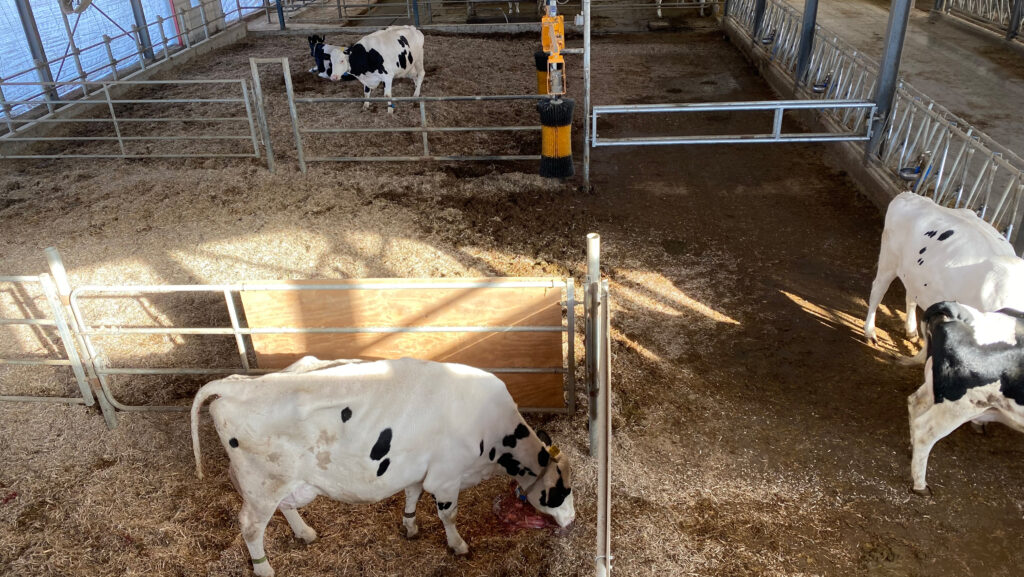Five ways to achieve zero treatments and losses in calves
 © Jodi Wallace
© Jodi Wallace Getting the basics right – consistently – and putting calves first led to a four-year period of zero treatments and zero losses in calves for Canadian vet and dairy farmer Jodi Wallace.
Working for Ormstown Veterinary Hospital in Quebec, Jodie is also involved in her family’s 486ha (1,200-acre) farm, which operates 100 cows producing an average yield of 12,800kg.
See also: 7 ways to prevent colostrum contamination
She said that when building a new calf barn in 2014, the family decided to focus on getting the basics right.
This included adding a “newborn sauna”, which dries calves and warms them up before they move to the rearing pens.
From birth, calves are reared in pairs (or, if odd numbers, a group of three) and fed ad-lib from teats on automatic machines.
“We put calves first and put people in charge who care.
“Our ‘zero zero’ broke when we went on a family holiday, and in that one week, we had four sick calves and one death.
“People had too much work and no time for calves and cleaning,” she said.
“Having a sick calf is both economical [in terms of financial impact] and emotional, so we need to look for opportunities to improve.
“No matter the size of your herd – 100 cows to 1,000 cows – all these basics apply.”
Jodie said to achieve “zero zero” calf rearing, targets should be better than industry standards.
Instead of less than 5% mortality, for instance, her objective is 0-2%.
Where a treatment rate of fewer than 25% of calves is advised, her aim is 0-15%.
And although the target is for calves to double their birthweight in 56 days (typically weaning age), she said that it was possible in 30-45 days, or less.
Below are Jodi’s suggestions to get the basics right.
1. Focus on colostrum quality
- If the Brix refractometer reading for colostrum is below 24%, something is wrong with dry-cow rations.
- Provide a stress-free environment.
- If using just-in-time calving pens, note whether a newborn calf is found in the pen or the passageway – her first meal could be a mouthful of manure.
- Keep calving areas clean.
- Have a sink and hot water tank close to the calving area and calf pens to make it easy to clean things.
- Use a portable milker for the first colostrum harvest, or, in a large herd, make a tie-stall facility for easy milking options to reduce cow stress.
- Avoid overcrowding dry cows, feed correctly to reduce metabolic issues, and keep them cool and comfortable.
- Add a “calving corner” inside the pen, where cows can hide to calve, as in nature. This area has solid sides about 25cm off the ground. The gap allows the cow to look for predators.
- Use the dry period to vaccinate cows to prevent calf scour by boosting their colostrum antibodies.
2. Feed more clean colostrum
- The first 24 hours of life affect the heifer calf for the rest of her life. Feed colostrum that is more than 24% on the Brix refractometer and has less than 10,000 total bacteria count and zero coliforms, within two hours of birth.
- Feed at 10% of bodyweight.
- Give the first drink from a teat within one hour of birth as the calf is full of adrenalin and wants to drink. Thereafter, adrenalin levels fall and the calf naturally wants to hide and sleep.
- Larger herds can freeze and store top-quality (or antibody-enriched) colostrum in 3-4 litre bags. Use a machine to thaw and warm to the correct temperature without denaturing the protein. Where there is disease pressure (such as Johne’s or mycoplasma), pasteurise colostrum.
- The calf’s second and third meals should be of transition milk – this is another superfood.
3. Feed more clean milk
- Calves need calories – if a calf’s intake is limited, her milk yield as a cow is limited.
- Calves cannot grow if they are expending a lot of energy combating disease challenges and trying to keep warm.
- Feed at least 8 litres of milk a day – to get intakes, feed two or three times a day or ad-lib via machine – this mimics nature.
- Feed using teats – the desire to suckle lasts for about 10 minutes, and if a calf drinks all her milk in three minutes, she is likely to cross-suckle.
- Make sure the milk is scrupulously clean.
- Ensure calves can drink correctly – standing on tiptoes leads to nutritional scour, as it affects oesophageal groove closure and gut microflora. Measure a cow’s teat height as a guide (cows on Jodie’s farm average 59cm).
- Ensure calves can also reach clean, fresh water.
4. Housing
- Supply clean air – no pneumonia.
- Provide plenty of clean, dry bedding. Avoid adding clean straw to dirty straw – this does not help control ammonia levels.
- Rear calves in pairs, then in groups of eight to 10.
- Monitor air circulation at calf level.
- Place calves away from walls to avoid draughts.
- Use positive ventilation systems to remove gas and humidity; have a different system for summer and winter.
- Goal is below 65% humidity.
5. Monitor progress
- Write everything down, particularly in large herds with multiple staff. Have a simple calf card on the pen or use a whiteboard for information.
- Test for passive transfer by blood testing before seven days of age – look for at least 70% of calves with more than 5-8g/decilitre total protein.
- Measure weights – it is possible to double birthweight sooner than the outdated industry standard of 56 days (as little as 23 days on Jodie’s farm).
- Use (peeled) bananas to reward calves coming to be weighed.
Jodi Wallace was speaking at the recent TotalDairy conference in Stratford-upon-Avon.
